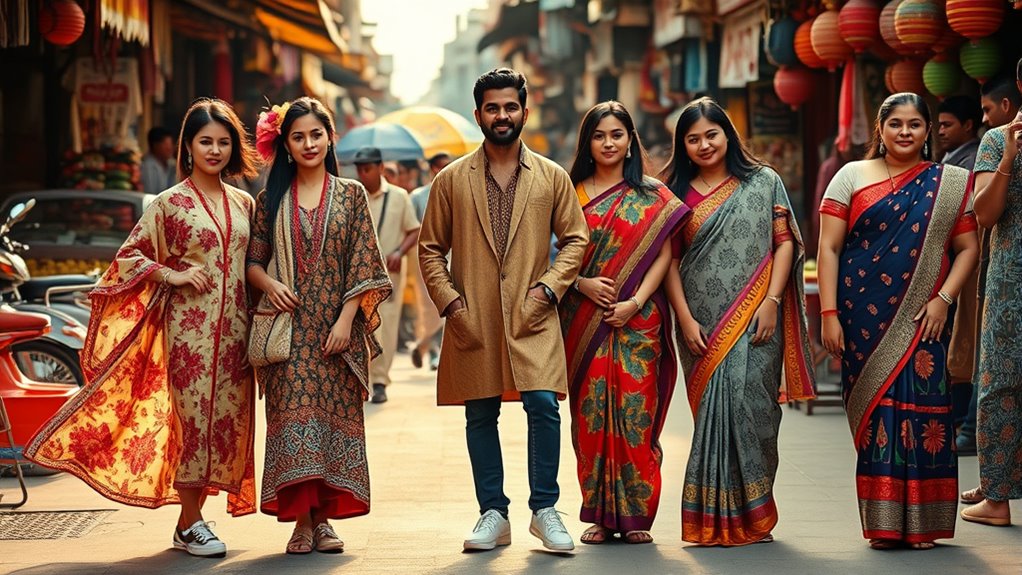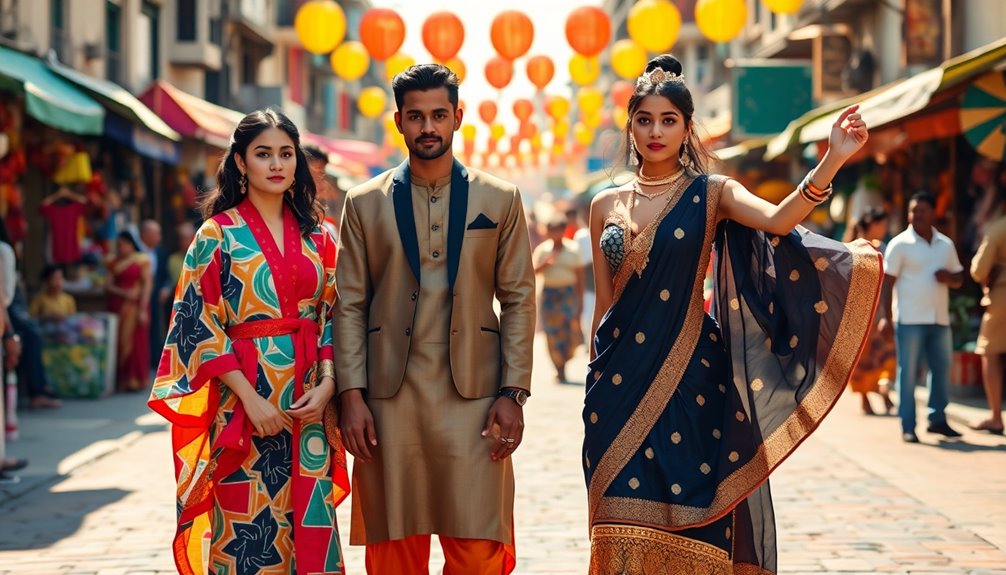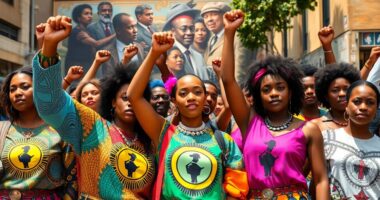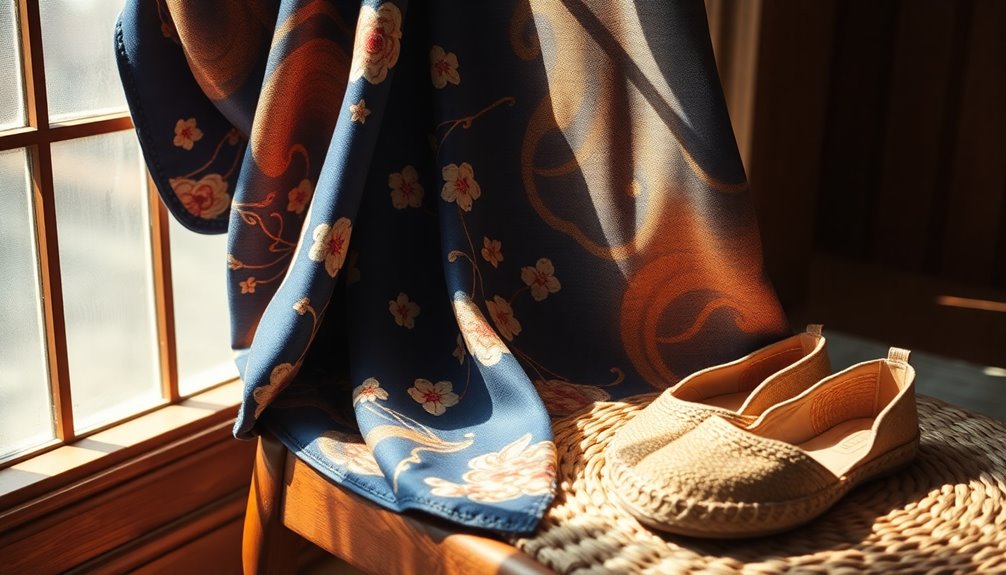Traditional clothing around the world offers vibrant tales of culture and identity. You’ll find Maasai garments bursting with color, Indian saris rich with regional history, and Scottish kilts symbolizing clan pride. Today, designers blend these cherished elements with modern styles, creating innovative pieces that honor the past while appealing to contemporary tastes. These transformations connect you to global traditions and promote cultural understanding. Keep exploring to uncover even more fascinating stories behind these garments.
Key Takeaways
- Traditional clothing incorporates modern designs, fabrics, and cuts, creating a fusion that respects cultural heritage while appealing to contemporary tastes.
- Designers often reinterpret traditional garments, blending classic elements with modern fashion trends to create unique, wearable art.
- Global fashion influences lead to the adaptation of traditional attire, allowing for diverse expressions that resonate with younger generations.
- Events like fashion weeks showcase modern twists on ethnic wear, promoting cultural pride and encouraging global appreciation of traditional garments.
- Sustainable practices are increasingly embraced, with traditional techniques being used in modern designs, highlighting craftsmanship and reducing environmental impact.

Have you ever wondered how traditional clothing reflects a culture’s history and identity? It’s fascinating how different garments tell stories of the people who wear them, often weaving together threads of history, craftsmanship, and cultural significance.
Take the Maasai clothing from Kenya, for instance. Its bright fabrics and intricate beadwork not only showcase artistic talent but also symbolize courage and connection to the sky. When you see a Maasai warrior in vibrant red and blue, you’re witnessing a visual representation of bravery and identity.
Similarly, the Indian sari serves as an iconic garment that varies greatly across the country. Each region has its own style and fabric, echoing local traditions and histories. You could explore the intricate patterns and colors of a Banarasi silk sari, which tells tales of royal courts, or you might find a simple cotton sari perfect for everyday wear. Each piece is more than just clothing; it’s a narrative of its origin.
Then there are Scottish kilts, which you might associate with ceremonies and festivities. These garments aren’t just about fashion; they signify clan affiliations and cultural heritage. The patterns or tartans you see often represent family lineage. When worn, a kilt connects the wearer to their ancestors and their stories.
In Vietnam, the conical hat stands as a symbol of both practicality and cultural identity. It’s not merely a fashion statement; it reflects the agricultural history of the Vietnamese people.
Similarly, the kimono in Japan embodies centuries of tradition. You can sense the deep cultural significance when you see someone wearing it during special occasions, reminding you of the importance of preserving history.
These traditional garments have evolved over time, often adapting to modern influences while retaining their core symbolism. Today, you might see elements from these clothing styles incorporated into contemporary fashion. Designers around the world draw inspiration from traditional attire, creating modern twists that still pay homage to their roots. This blend of old and new not only keeps traditions alive but also fosters cultural exchange. Wearing traditional clothing today can signify unity and belonging, reminding you of your own cultural heritage while promoting a greater understanding of global diversity.
Frequently Asked Questions
How Can I Incorporate Traditional Clothing Into My Everyday Wardrobe?
To incorporate traditional clothing into your everyday wardrobe, start by mixing and matching pieces.
Pair a colorful African print shirt with jeans or wear a silk Indian kurta over leggings for comfort and style.
Opt for tailored fits to avoid looking oversized.
Incorporate accessories like a beaded Native American necklace or a traditional scarf for added flair.
Don’t shy away from blending these pieces with modern basics to create a unique, fashionable look!
Are There Any Sustainable Brands That Focus on Traditional Clothing?
Yes, there are several sustainable brands that focus on traditional clothing.
You might consider checking out Christy Dawn, which emphasizes traditional craftsmanship and uses locally sourced materials.
Ginew incorporates Indigenous cultural elements into its designs, while brands like Pact and Fair Indigo prioritize organic fabrics and fair labor practices.
What Events Celebrate Traditional Clothing Globally?
You might find it surprising that while you’re browsing social media, events celebrating traditional clothing are taking place worldwide.
From National Dress Day, where you’re encouraged to don your cultural attire, to local fashion festivals showcasing heritage-inspired designs, these gatherings highlight diversity.
Global Cultural Clothing Day aims to promote traditional wear in everyday settings, and parades often celebrate vibrant cultural garments, uniting communities through shared heritage and style.
How Do I Care for Delicate Traditional Fabrics?
When you care for delicate traditional fabrics, always use cool water and mild detergents to avoid damage.
Hand wash instead of machine washing to maintain control, and never wring or twist the fabric; gently press out excess water.
For drying, air-dry away from direct sunlight to preserve color and texture.
Each fabric type, like silk or wool, has specific care needs, so research those to guarantee your pieces remain beautiful and intact.
Where Can I Buy Authentic Traditional Clothing Online?
Did you know that over 70% of consumers prefer shopping online for authentic traditional clothing?
You can find genuine options at websites like KALKI Fashion for Indian attire, NewMoonDance for Chinese Hanfu, and Recollections.biz for historically-themed garments.
These platforms emphasize quality and authenticity while offering international shipping. Always check customer reviews to verify you’re getting the real deal.
Shopping online makes it easy to explore diverse traditional styles from the comfort of your home!
Conclusion
As you explore the vibrant tapestry of traditional clothing, you can’t help but notice how these styles evolve with each generation. Coincidentally, the modern twists you see today often reflect the rich histories they stem from. Whether it’s a fusion of fabrics or a contemporary take on classic patterns, these garments tell stories of culture and identity. Embracing both tradition and innovation, you realize that fashion isn’t just about clothing; it’s about celebrating our shared humanity.










